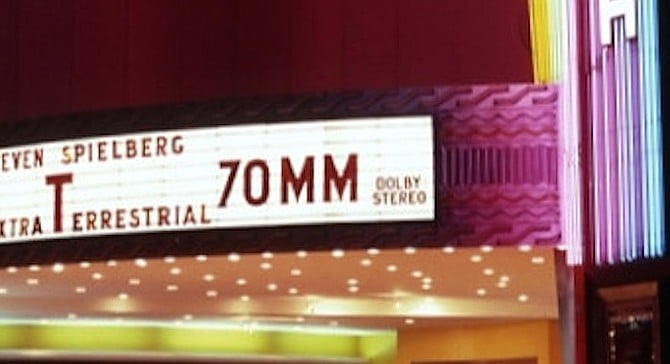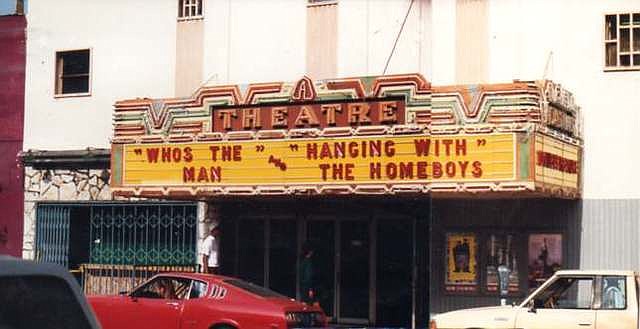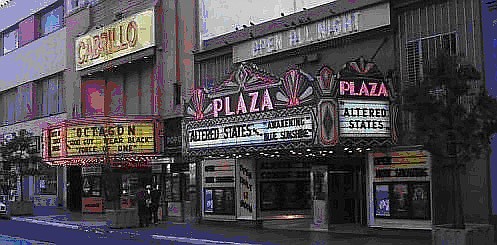 Facebook
Facebook
 X
X
 Instagram
Instagram
 TikTok
TikTok
 Youtube
Youtube

During the marathon COMBO auction, on television last week, the only movie-related item to come up for grabs was a one-year pass for two to any of the Spreckels, Broadway, and Tower theatres. It went for a bid of 150 dollars, something like that. Which translates as roughly 30 trips to these theatres. As one who has visited these theatres a combined total of about twelve times in two years, I cannot consider this to be among the craftiest investments on record, unless the buyer is involved in deep and urgent research into the subject of action movies made in Hong Kong. Nevertheless, this investment has its heartening aspect — the commitment to go on attending these three theatres, no matter what, thick or thin (this, at a time when empty theatres and half-empty theatres and worse are regular, souring features on moviegoing circuits).
Whatever might be offered as excuses not to go out to a movie — the cost of the ticket, the cost of gasoline, the fuzzy focuses and lapses of concentration of some projectionists, the dirtiness of some screens and the stickiness of some floors, the narrowness of variety in San Diego movies — the fact remains that, all things considered, the best conditions for watching movies are in theatres; and even while this column dabbles in playing favorites, one movie over another, it is never intended to dissuade anybody from seeing for himself. That said, the following spot checks and idle comments and undisguised plugs are presented on the theatres that are frequent, or fond, haunts, with apologies for the short shrifts, the omissions due to space, and the neglect of theatres that are outside my range, geographically.
The Fashion Valley Four, with its twilight-hour bargain prices and its promotional gimmicks, the anti-Monday night football campaign, the soft drinks at the snack bar which change names with the movies on exhibit (Lemon-lime becomes “Soylent Green" for a time), and the inexhaustible, hardsell newspaper advertising which always suggests a reason for you to see the movie perhaps tries hardest. At least there is evidence that someone in this theatre is awake, and turning things over in his head, trying to reclaim the disaffected movie public. In any case, the smallness and simpleness of design of each of the Four (no trace of the Sistine Chapel ceilings and baroque statues of old-style movie “palaces”) create an atmosphere of professionalism, or seriousness, about movie viewing. These uncluttered theatres are not too distant from New York’s screening rooms for the press, and they are becoming more and more prevalent: Pacific Theatres’ Center 3 in Mission Valley, the Century Twins, the Parkway and UA Cinemas in El Cajon.
For the locations and upkeep of the theatres, for the selection, overall, of films exhibited, and for the belief in bargain pricing during early evening hours, the chain of Pacific Theatres, of the two major theatre chains in the area, is vastly preferable. (My private annoyance with Mann Theatres, formerly National General, probably originated when the Loma Theatre, which would prefer to run a movie for all of eternity, held Fiddler on the Roof for a full year — after two months, the ad became invisible in the theatre section — only to replace it at last with Man of La Mancha. Minor annoyances — the exasperating intermissions in normal-length movies, Straw Dogs and The Getaway, for the single purpose of drumming up snack bar trade are easy to find. But, for me personally, it is especially the provincial view of the district manager — the lack of openness, to put it quietly, the penuriousness, the coldness toward movie reviewers, one and all, that marks the Mann theatre chain as the bush league.)

The Casino Theatre, on 5th Street, south of “G,” and the Cabrillo, on the Plaza, and occasionally the Plaza Theatre, next door, offer triple features of action movies, primarily, but also sex movies, of the not-too-distant past. They are the principal spots where you can turn, regularly, in hopes to getting another look at, or catching up with, movies like One-Eyed Jacks, El Dorado, Beyond the Valley of the Dolls, Rio Conchos, Night of the Following Day, Coogan’s Bluff, to take a few recent examples, or any one of the limitless number of cult movies that might randomly appear for a three-day stand. Just as importantly, these theatres are the nearest thing, locally, to the sensation of deeply submerged, big-city, all-night movie going as it is known in Times Square. Which means that at these theatres, for example, unescorted women are unheard of, and you are extremely cautious about where you sit and where you step.

The Strand, in Ocean Beach, the Linda, in Linda Vista, the Ken, somewhere, the Roxy in Pacific Beach, and a few further-flung theatres charge less than a dollar for double-features of third- or fourth-run current movies, and should be singled out for the economic benefits alone, but also for the attendant excitements of witnessing movies in such bargain-basement circumstances — the throngs that turn out, their rambunctiousness, the popcorn and dixie cups on the floor.
The Unicorn, in La Jolla, where it belongs, is in a class by itself. While its programming enters occasional phases of strict commercialism, at which time this theatre might be wrongly confused with any other theatre, its constants always preserve the image of a bona fide specialty house — the bookstore that approves of browsing, for example, which you pass through to reach the theatre; the complimentary hot drinks which are deceptively labeled "Tea” and “Coffee,” the lengthy brochures of upcoming programs which seldom come out on time, but which you can peruse for hours, fold and refold like roadmaps, and pin to the wall for continual reference, inarguably, the Unicorn’s programming is San Diego’s most various, most evidently conscientious, and most original; and it is the one theatre complicated enough to demand careful exploration of its far slopes and concealed caves — the unannounced midnight showings on Saturday nights (these deserve better turnouts than they usually get - what else is doing at midnight in La Jolla? — and with a phone call the day of the showings you can find out what is scheduled), the children’s matinees, the special programs in collaboration with outside groups, women’s groups, gay groups, UCSD Extension School, others.
Behind the Unicorn in the showing of foreign films, classics, etc., but to be commended for occupying the field at all, are the Academy and the Capri, on the other side of town, toward San Diego State, although the latter has been slumbering as a second-run theatre since Spring unfortunately. One other, the La Paloma, in Encinitas, the only theatre north of La Jolla, has demonstrated itself to be a big disappointment. It was probably incorrect to expect anything from this quaint place, with its church-pew seats and windows at the back of the auditorium; one assumed a certain intellectual standing simply because its snack bar dispenses items like guava juice and oatmeal-date bars. Still, an infrequent offbeat film turns up there (the local premiere of Bob Downey’s Greasers Palace), and the experience of attending can be heightened by a meal beforehand at the Coffee Mill, or in the peaceful company of the old folks at the Kardiff Kitchen, or, if the movie you’re seeing is a surf film, at the A & W drive-in, or, if the mood you’re in is the one where you no longer care whether you see mother daylight, at Captain Keno’s.
The Cinema Leo, Pacific Beach, is the city’s solitary revival theatre, and the only theatre to do without seats. (There is a three-abreast row of seats on one side, but, because the screen extends to the floor, the only clear view is from the front most seat: if anyone sits in front of you, it is neck-craning from then on.) Staying primarily, but not absolutely, in Thirties’ films, the Leo’s selection of films, except in its predictable tilt towards Fields, Laurel and Hardy, the Marxes, seems on the surface to be bafflingly arbitrary and unmeditated, but at least it avoids fashion-consciousness.
Another group devoted to old films, particularly exclusively musicals, is an organization calling itself “Hollywood Musicals Unlimited.” It has been, of late, showing films at the Unicorn Theatre, the third Sunday of every month (this coming Sunday the program is Meet Me in St. Louis and White Christmas). In the future, the group plans to bring in guests (the talk is of Ann Miller and Jane Powell in January), and also in the future, the group plans to close doors and become a private club. Membership fees, used to finance the nonprofit film screenings, are five dollars per year.


During the marathon COMBO auction, on television last week, the only movie-related item to come up for grabs was a one-year pass for two to any of the Spreckels, Broadway, and Tower theatres. It went for a bid of 150 dollars, something like that. Which translates as roughly 30 trips to these theatres. As one who has visited these theatres a combined total of about twelve times in two years, I cannot consider this to be among the craftiest investments on record, unless the buyer is involved in deep and urgent research into the subject of action movies made in Hong Kong. Nevertheless, this investment has its heartening aspect — the commitment to go on attending these three theatres, no matter what, thick or thin (this, at a time when empty theatres and half-empty theatres and worse are regular, souring features on moviegoing circuits).
Whatever might be offered as excuses not to go out to a movie — the cost of the ticket, the cost of gasoline, the fuzzy focuses and lapses of concentration of some projectionists, the dirtiness of some screens and the stickiness of some floors, the narrowness of variety in San Diego movies — the fact remains that, all things considered, the best conditions for watching movies are in theatres; and even while this column dabbles in playing favorites, one movie over another, it is never intended to dissuade anybody from seeing for himself. That said, the following spot checks and idle comments and undisguised plugs are presented on the theatres that are frequent, or fond, haunts, with apologies for the short shrifts, the omissions due to space, and the neglect of theatres that are outside my range, geographically.
The Fashion Valley Four, with its twilight-hour bargain prices and its promotional gimmicks, the anti-Monday night football campaign, the soft drinks at the snack bar which change names with the movies on exhibit (Lemon-lime becomes “Soylent Green" for a time), and the inexhaustible, hardsell newspaper advertising which always suggests a reason for you to see the movie perhaps tries hardest. At least there is evidence that someone in this theatre is awake, and turning things over in his head, trying to reclaim the disaffected movie public. In any case, the smallness and simpleness of design of each of the Four (no trace of the Sistine Chapel ceilings and baroque statues of old-style movie “palaces”) create an atmosphere of professionalism, or seriousness, about movie viewing. These uncluttered theatres are not too distant from New York’s screening rooms for the press, and they are becoming more and more prevalent: Pacific Theatres’ Center 3 in Mission Valley, the Century Twins, the Parkway and UA Cinemas in El Cajon.
For the locations and upkeep of the theatres, for the selection, overall, of films exhibited, and for the belief in bargain pricing during early evening hours, the chain of Pacific Theatres, of the two major theatre chains in the area, is vastly preferable. (My private annoyance with Mann Theatres, formerly National General, probably originated when the Loma Theatre, which would prefer to run a movie for all of eternity, held Fiddler on the Roof for a full year — after two months, the ad became invisible in the theatre section — only to replace it at last with Man of La Mancha. Minor annoyances — the exasperating intermissions in normal-length movies, Straw Dogs and The Getaway, for the single purpose of drumming up snack bar trade are easy to find. But, for me personally, it is especially the provincial view of the district manager — the lack of openness, to put it quietly, the penuriousness, the coldness toward movie reviewers, one and all, that marks the Mann theatre chain as the bush league.)

The Casino Theatre, on 5th Street, south of “G,” and the Cabrillo, on the Plaza, and occasionally the Plaza Theatre, next door, offer triple features of action movies, primarily, but also sex movies, of the not-too-distant past. They are the principal spots where you can turn, regularly, in hopes to getting another look at, or catching up with, movies like One-Eyed Jacks, El Dorado, Beyond the Valley of the Dolls, Rio Conchos, Night of the Following Day, Coogan’s Bluff, to take a few recent examples, or any one of the limitless number of cult movies that might randomly appear for a three-day stand. Just as importantly, these theatres are the nearest thing, locally, to the sensation of deeply submerged, big-city, all-night movie going as it is known in Times Square. Which means that at these theatres, for example, unescorted women are unheard of, and you are extremely cautious about where you sit and where you step.

The Strand, in Ocean Beach, the Linda, in Linda Vista, the Ken, somewhere, the Roxy in Pacific Beach, and a few further-flung theatres charge less than a dollar for double-features of third- or fourth-run current movies, and should be singled out for the economic benefits alone, but also for the attendant excitements of witnessing movies in such bargain-basement circumstances — the throngs that turn out, their rambunctiousness, the popcorn and dixie cups on the floor.
The Unicorn, in La Jolla, where it belongs, is in a class by itself. While its programming enters occasional phases of strict commercialism, at which time this theatre might be wrongly confused with any other theatre, its constants always preserve the image of a bona fide specialty house — the bookstore that approves of browsing, for example, which you pass through to reach the theatre; the complimentary hot drinks which are deceptively labeled "Tea” and “Coffee,” the lengthy brochures of upcoming programs which seldom come out on time, but which you can peruse for hours, fold and refold like roadmaps, and pin to the wall for continual reference, inarguably, the Unicorn’s programming is San Diego’s most various, most evidently conscientious, and most original; and it is the one theatre complicated enough to demand careful exploration of its far slopes and concealed caves — the unannounced midnight showings on Saturday nights (these deserve better turnouts than they usually get - what else is doing at midnight in La Jolla? — and with a phone call the day of the showings you can find out what is scheduled), the children’s matinees, the special programs in collaboration with outside groups, women’s groups, gay groups, UCSD Extension School, others.
Behind the Unicorn in the showing of foreign films, classics, etc., but to be commended for occupying the field at all, are the Academy and the Capri, on the other side of town, toward San Diego State, although the latter has been slumbering as a second-run theatre since Spring unfortunately. One other, the La Paloma, in Encinitas, the only theatre north of La Jolla, has demonstrated itself to be a big disappointment. It was probably incorrect to expect anything from this quaint place, with its church-pew seats and windows at the back of the auditorium; one assumed a certain intellectual standing simply because its snack bar dispenses items like guava juice and oatmeal-date bars. Still, an infrequent offbeat film turns up there (the local premiere of Bob Downey’s Greasers Palace), and the experience of attending can be heightened by a meal beforehand at the Coffee Mill, or in the peaceful company of the old folks at the Kardiff Kitchen, or, if the movie you’re seeing is a surf film, at the A & W drive-in, or, if the mood you’re in is the one where you no longer care whether you see mother daylight, at Captain Keno’s.
The Cinema Leo, Pacific Beach, is the city’s solitary revival theatre, and the only theatre to do without seats. (There is a three-abreast row of seats on one side, but, because the screen extends to the floor, the only clear view is from the front most seat: if anyone sits in front of you, it is neck-craning from then on.) Staying primarily, but not absolutely, in Thirties’ films, the Leo’s selection of films, except in its predictable tilt towards Fields, Laurel and Hardy, the Marxes, seems on the surface to be bafflingly arbitrary and unmeditated, but at least it avoids fashion-consciousness.
Another group devoted to old films, particularly exclusively musicals, is an organization calling itself “Hollywood Musicals Unlimited.” It has been, of late, showing films at the Unicorn Theatre, the third Sunday of every month (this coming Sunday the program is Meet Me in St. Louis and White Christmas). In the future, the group plans to bring in guests (the talk is of Ann Miller and Jane Powell in January), and also in the future, the group plans to close doors and become a private club. Membership fees, used to finance the nonprofit film screenings, are five dollars per year.
Comments